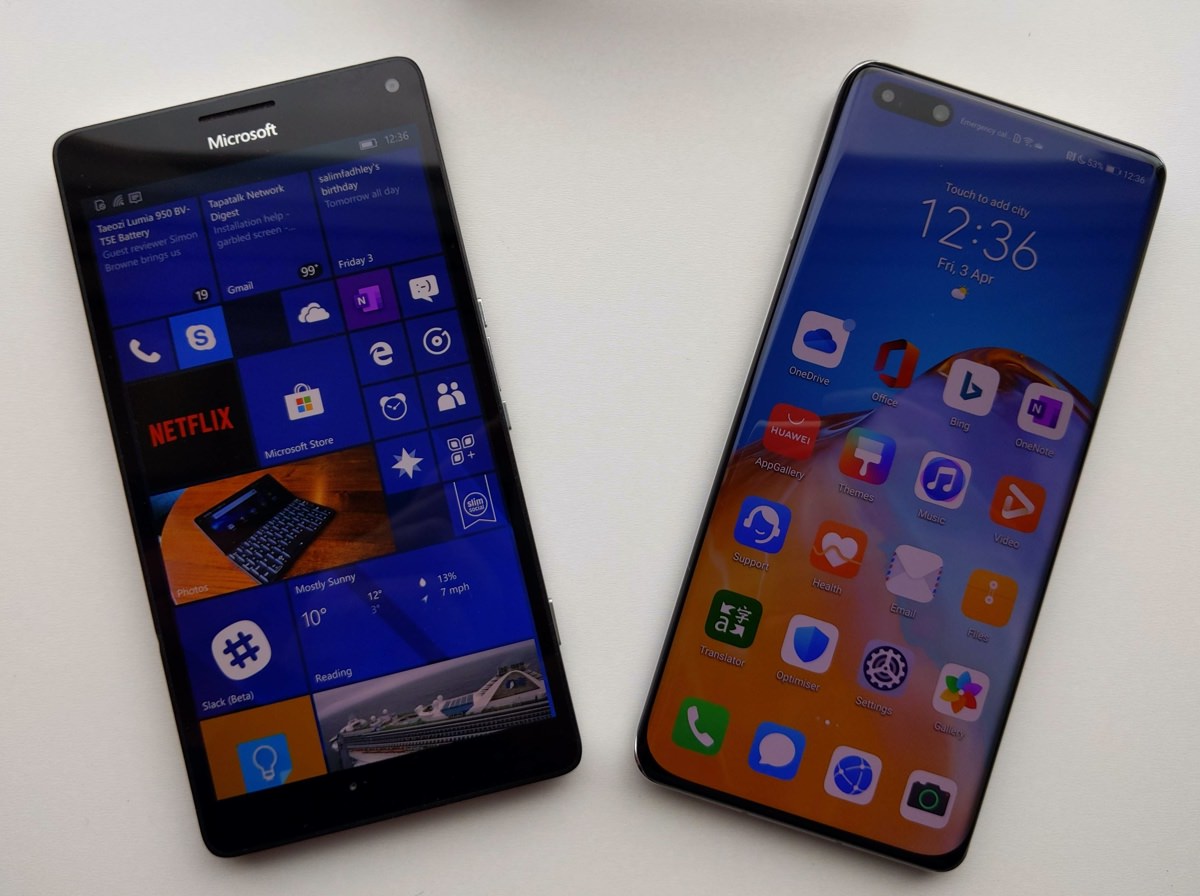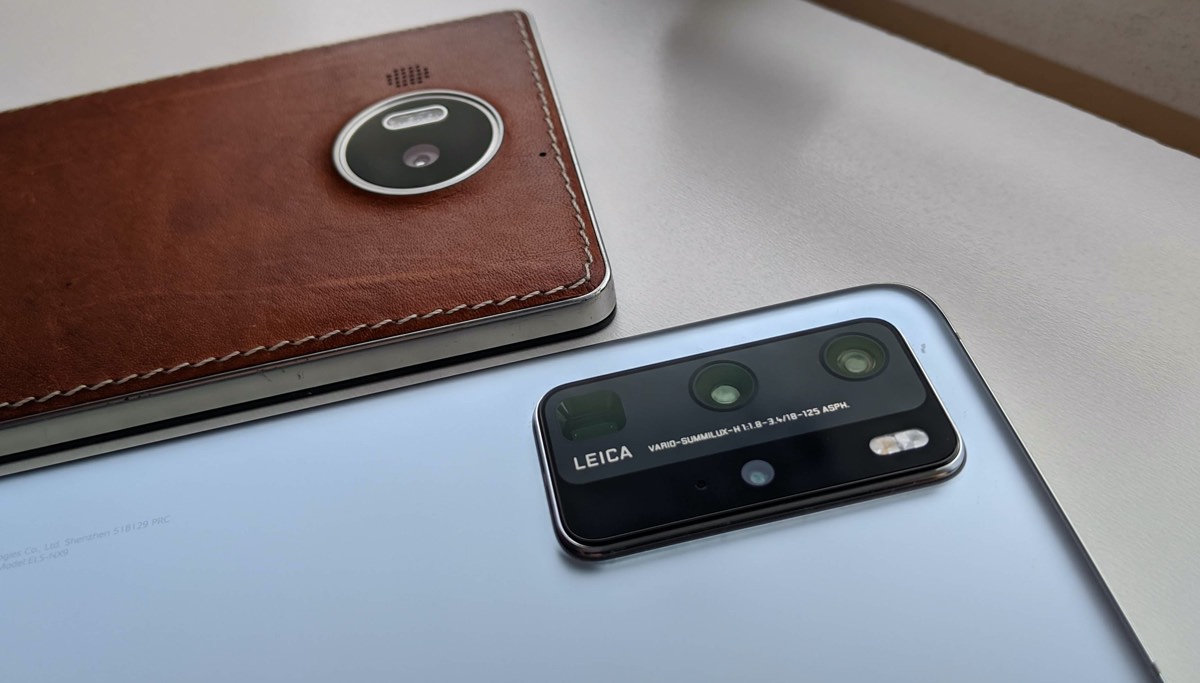
Lumia 950 XL and Huawei P40 Pro

As usual, just for fun and curiosity, I've shaded in green an obvious 'win' for either device. Any row where a winner would be totally subjective is left uncoloured. Or, where all devices are utterly excellent but in different ways, I've given each a 'green'(!)
[By the way, if you're viewing this feature on a phone then the table may well cause you problems. Try viewing in landscape mode? Failing that, go view this on a laptop or tablet!]
| Microsoft Lumia 950 XL | Huawei P40 Pro | |
| Date first available | November 2015 | April 2020 |
| Current price, availability | No longer officially for sale, though it's often on clearance prices if you're lucky and at outrageous profiteering prices due to rarity (if you're not!) | £900. But you do get absolute top specs in terms of hardware, components and build. And it's cheaper than many iPhones and Samsung Galaxy flagships. But yes, £900 isn't cheap. |
| Dimensions, form factor, weight |
152 x 78 x 8mm, plastic chassis and replaceable backs (plastic/leather/wood etc, from Mozo, as modelled here!), 165g, bezels are comparatively small |
158 x 73 x 9mm, 209g, taller and narrower. Heavy, but reassuringly so. Aluminium frame with reinforced corners, frosted glass on the rear. Supplied with a nice clear TPU case. |
| Durability | No specific durability metrics, though the fact that the back comes off will help enormously for water damage, i.e. taking out battery and cards immediately, drying out the internals, even unscrewing the motherboard from the guts of the phone. I'm old-school here! All damage to the back or corners is trivial through replacement of the rear, but the screen's exposed, of course. The plastics used should absorb shock and, anecdotally, I've never bothered putting a case on any Lumia. Just saying. I think that fact is significant. |
IP68 rated for water and dust. Thumbs up. Doesn't actually 'win' here because it's still much more breakable if dropped, though. |
| Operating system, interface | Windows 10 Mobile, (dismissable) virtual controls, as needed, now officially updated to W10 Fall Creators Update (Redstone 3, Autumn 2017) with security to 'January 2020'. |
Android 10, March 2020 security, gesture controls available, or navigation buttons on-screen. EMUI 10.1 skin and interface. |
| Display |
5.7" AMOLED (1440p at 16:9 aspect ratio, matching most video media), Gorilla Glass 4, ClearBlack Display polarisers help with outdoor contrast, excellent viewing angles. Screen area is approximately 88 cm2 Glance screen available (in various colours) for always-on time, day and notification icons, plus some detailed info from a specified app, give the Lumia the win here. |
6.6" 1200p AMOLED, 19.5:9 ratio, toughened glass, screen area is roughly 105cm2 Also excellent and pretty good outdoors in the sun. Always on display for time, date and notifications, along with colour photo art. All off by default, but trivial to turn on in Settings. |
| Connectivity |
LTE, NFC (all uses), Wi-Fi b/g/n/ac, integral wifi tethering, Bluetooth 4.2 (all uses). Continuum connectivity to use a wide range of first and third party UWP apps on external displays as secondary screen, independent of the phone display. Includes the new NexDock 2, transforming the Lumia into a Windows 10 S laptop, effectively. |
LTE, NFC (all uses), Wi-Fi b/g/n/ac/ax, integral wifi tethering, Bluetooth 5.1 (all uses). Easy Projection desktop experience available via Type C connection. |
| Processor, performance | Snapdragon 810 chipset, 3GB RAM, faster than it's ever been now on the Fall Creators Update though still slower for almost everything than on the Android phone. Multi tasking and app resumption is excellent though, at least with all the modern UWP apps |
Kirin 990, 8GB RAM, lightning fast at everything |
| Capacity | 32GB internal storage, expandable via (cheap) microSD to extra 256GB | 128/256/512GB internal storage, plus nanoMemory expansion if you don't need the second nano-SIM slot. Yes, the NM thing is a pain, but the built-in storage is enough for the vast majority, I contend. |
| Imaging (stills) |
20MP PureView f/1.9 1/2.4" BSI sensor, Phase Detection auto-focus, dedicated camera shutter button and launch key, 1.5x lossless digital zoom (in 8MP oversampled mode, and lossy digital after that), OIS. 'Rich Capture' produces customisable HDR shots and 'dynamic flash', with triple LED illumination. Outstanding shots in most light conditions, with just focussing issues in low light as an Achilles heel. |
Main camera: 50 MP RYYB, f/1.9, 1/1.28", omnidirectional PDAF, OIS The specifications are superb, with the only real weak spot being the lossy zoom from 2x through (progressively) to 4.9x. A separate imaging test is planned in the next few days, watch the site! Will the 950 XL's legendary image purity be matched? |
| Imaging (front/selfie) |
5MP front camera, no auto-focus | 32MP, f/2.2 front camera, PDAF |
| Imaging (video) | Up to 4K, optically (and optionally digitally) stabilised, with 'Best photo' 8MP grabbing built-in, plus Rich Recording and HAAC microphones for high quality, gig-level stereo capture. | Up to 4K video capture, with EIS, high quality stereo audio capture. |
| Music and Multimedia (speakers) |
A tinny mono speaker by modern standards, though as ever you can trade volume for fidelity in a simple tweak on Lumias. | Excellent, loud, and bassy speaker, though mono, unlike the stereo arrangements on many flagships these days. |
| Music (headphones) |
3.5mm headphone jack, A2DP+AptX, so great wired and wireless headphone audio too. | No 3.5mm headphone jack, so reliant on Type C dongles and/or Bluetooth audio. |
| Navigation |
Windows 10 Maps is now pretty mature and impressive, especially once you've learned the live traffic routine trick! Offline maps save a lot of data bandwidth for those on tight contracts or anyone in a low signal (data) area, and these get the win here. |
No Google means no Google Maps, of course. Not even Huawei Maps, though it's fairly easy (for someone tech-minded) to install HereWeGo (new name for HERE Maps) via an alternate app store, and this includes the same feature set as Windows 10 Maps. |
| Cortana/Voice | Cortana was in theory now mature and well integrated, though functionality has been falling away and most attempts to rouse her end in failure in 2020. | No Google Assistant, of course, so it's Huawei's new HiVoice assistant ("Hi Ceila"), which is currently absolutely terrible. It'll get better, of course, and at least it's supported (unlike Cortana), but it's still not getting a 'green box' from me. |
| Battery, life | Removable 3000mAh battery, and the ability to change cells gets the win here (and you CAN still buy decent spare batteries), plus USB Type C Power Delivery (up to 3A, so 15W) and 1A Qi wireless charging built-in also helps. However, a Lumia running Windows 10 Mobile will now discharge in 24 hours even if you don't use it much. |
Sealed 4200mAh battery, gets easily through a day, though depends on the use case for the phone. Type C port supports proprietary 40W fast charging, plus 27W Qi wireless (and reverse wireless) charging |
| Cloud aids | Windows Photos syncs across all signed-in devices, subject to your OneDrive tariff (stingy, unless you have Office 365), should you have thousands of images in the system. Plus Windows 10 backs all your media, application data and settings to a separate backup folder system, tariff-free on OneDrive, for easy restoration on a new or factory reset phone. | No Google Photos means that you're on your own a little here. Putting Microsoft's OneDrive on (via a different app store to Huawei's) means that you then get all your Lumia photos plus auto-upload there, which is absolutely fine and probably what you want. Hey, Huawei, preinstalling OneDrive would have been sensible though, eh? |
| File compatibility | As with all Windows phones, plugging into a Windows PC gives full drag and drop to the phone's user file system. Plugging into a Mac sadly isn't possible anymore. | Plugging into a PC gives immediate MTP file access, plus this works well on a Mac with Google's Android File Transfer utility, for drag and drop of all user files. Seamless and lightning fast. |
| Biometrics | Iris recognition ('Windows Hello') works well unless you wear varifocals(!), but takes a couple of seconds (including an animation!) in real world use. There's also no official way of paying in shops using this. |
There's a basic photo-based face unlock, but for security there's a very good optical in-screen fingerprint ensor. This is faster and more accurate than any others I've tried, and gets the phone a win here. However, although it supports 'Huawei Pay', this has non-existent support in most Western countries, so you can't 'tap to pay'. Maybe things will improve throughout the year? |
| Applications and ecosystem | Windows 10 Mobile has most (though not all) mainstream apps and services covered. Often third party clients are involved, mind you, there are companies who hate Microsoft so much that they simply refuse to write for Windows, it seems. And 'long tail' niche/boutique apps are hard to find for real world companies and shops. |
Interestingly, Bing is preset for search and Office is preinstalled, i.e. out of the box. The Google Play Store is explicitly prohibited (by the Trump regime etc), and Huawei has a basic AppGallery store, but the majority of what you need isn't there (yet). APKPure is a generic Android app store that's worth sideloading, and then use this as well, as it gives access to all the other Microsoft applications and services. Note that actual sideloading of original Google applications is more complicated and even then there's no guarantee that they'll actually work, or keep on working. |
| Upgrades and future | Windows 10 Mobile is now effectively out of support. From now on, it will be useable but with more and more service caveats applying. Still, 'end 2019' was a full four years since the Lumia 950 XL was launched, so it's hard to complain. | I'm sure Huawei will keep this bang up to date into 2022. As to whether they'll still be a major player in the Western world, given this (enforced) non-Google approach, that remains to be seen! |

Verdict
Adding up the green 'wins' (for fun?!) gives a 11-8 win to the much newer device, a much closer result than for other recent flagships, thanks to the independence of Huawei now from the might of Google's apps and services. All of a sudden I'm comparing a smartphone which never had that many apps and services in the first place (the Lumia) with one that has similarly few, but for totally different reasons. In theory, you can still sideload most Google items onto the P40 Pro, but I don't see why anyone would - the whole POINT of choosing to buy this is to avoid Google, etc.
Your comments welcome.
